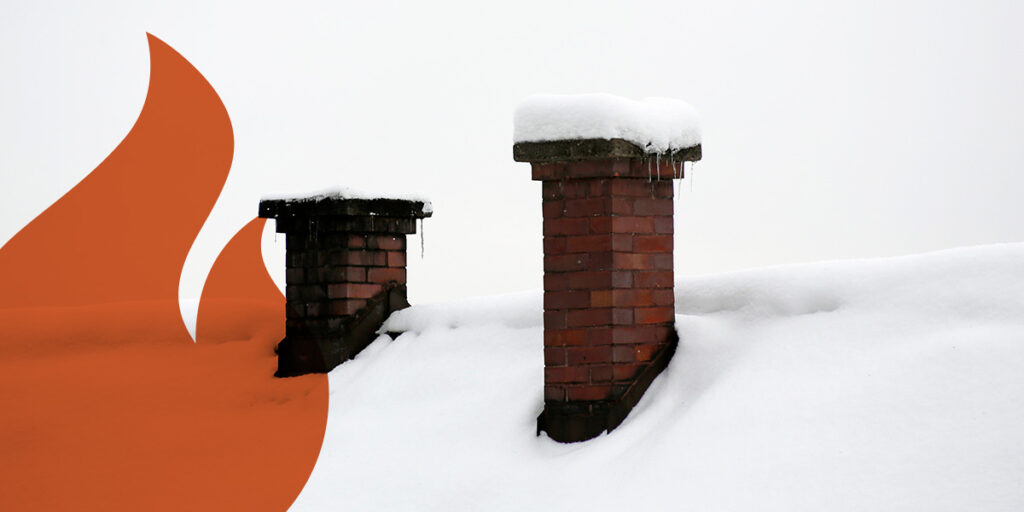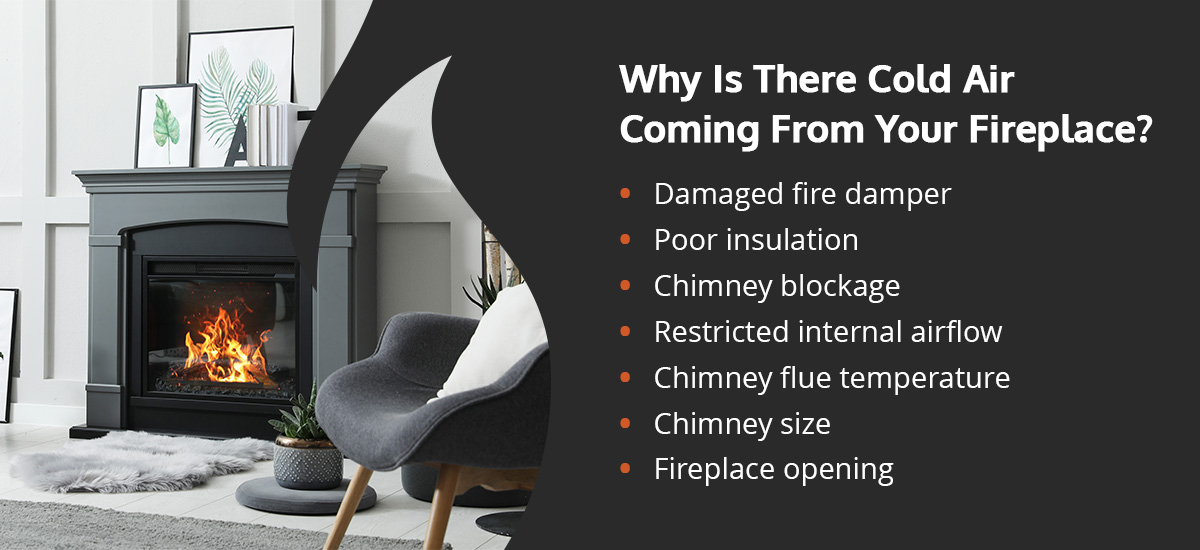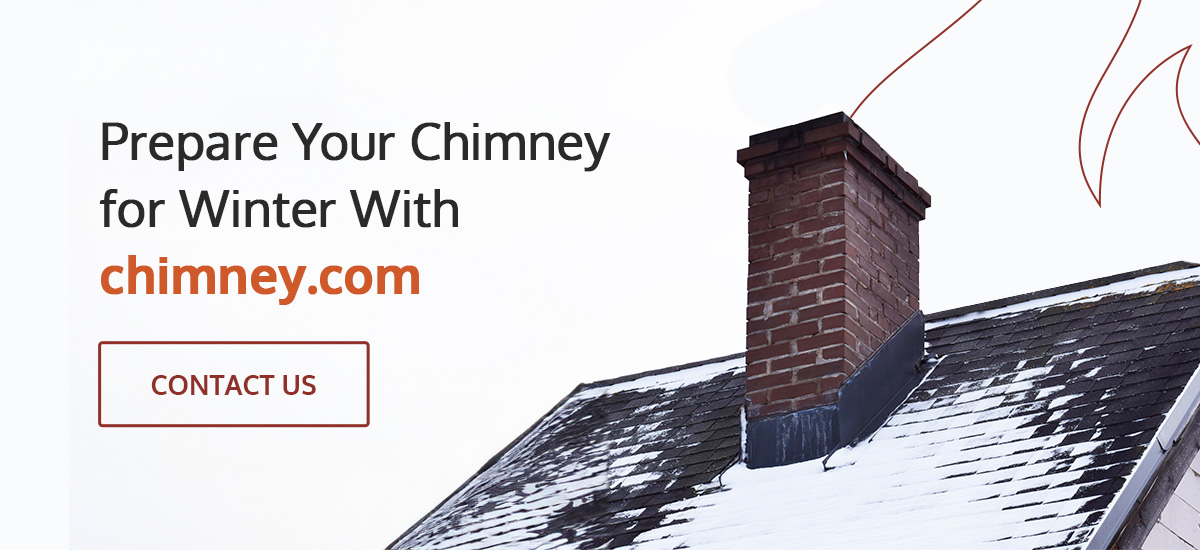How Does Cold Winter Weather Affect Your Chimney?

10/27/23
There’s nothing better than cozying up next to your fireplace with a warm drink or glass of wine in the winter. As the cold months approach, you want to know you can enjoy your time in front of the fireplace, especially after a long day at work or on a relaxing weekend indoors. Can you imagine if you couldn’t use a fireplace this winter? Your days might seem a little colder and longer.
The good news is that a cold, fireless winter is just a thought. In reality, there are many ways to ensure your fireplace functions through the winter. One of those solutions is preparing your chimney for the cold winter months. But before you get to that, it’s best to understand how cold conditions can affect your chimney and how you can prevent them.
Backdrafts From the Chimney: The Stack Effect
Chimney backdraft is common as part of the winter stack effect. The stack effect happens when there is a difference in indoor and outdoor temperatures. It can occur with and without a fire in your fireplace.
For example, your home might be warmer in winter due to extra heating compared to the outdoor environment. Because hot air rises and cold air sinks, hot internal and cold external air can create a pressure difference in your home in winter.
This pressure difference applies to your fireplace, too. When the heat from your fireplace or indoor space rises, it can create a positive pressure in the chimney. At the same time, cold and dense outdoor air can enter the fireplace through gaps and cracks in your chimney or masonry.
The cold air might enter and cool your chimney faster than warm air, creating negative pressure. This negative pressure can pull the cold air from the chimney into the fireplace, creating a reverse draft or backdraft. A backdraft or cold air from your chimney can force smoke from the fireplace back into your home instead of being funneled out.
Dangers of a Backdraft
Backdrafts can affect your home and health. Here are some dangers of a chimney backdraft:
- Carbon monoxide poisoning: A backdraft can force smoke into your home when a fire burns. This smoke often contains harmful chemicals like carbon monoxide and other organic substances. Inhaling these chemicals can lead to carbon monoxide poisoning.
- Allergies: Smoke from the backdraft can trigger allergies and respiratory illnesses like asthma. It can also cause eye and nose irritations.
- Soot: When smoke filters your home, it can create unpleasant smells. It can also create soot that sticks to windows and furniture and affects indoor air quality.
Why Is There Cold Air Coming From Your Fireplace?

Several factors can cause cold air to enter your fireplace:
- Damaged fire damper: Your chimney damper seals the chimney, preventing air from seeping in. If it is faulty or does not close properly, air can enter, causing a draft.
- Poor insulation: Cold air can seep through the back or exterior of a built-in wall fireplace without proper insulation.
- Chimney blockage: A blocked chimney can cause a backdraft, forcing cold air back into your home through the fireplace.
- Restricted internal airflow: Airflow is necessary to push smoke through the chimney. If your home does not have good ventilation, like enough doors or windows open, your chimney can create a backdraft, transferring smoke and cold air into your home.
- Chimney flue temperature: If the chimney flue on the floor of your fireplace is too cold, it can create a negative pressure, causing a backdraft.
- Chimney size: An incorrect chimney size or long chimney can create a draft.
- Fireplace opening: Even with a functioning chimney damper, the temperatures in your chimney and fireplace can be much cooler than in your home. Closing your fireplace entry with a door is one way to prevent drafts from entering through your fireplace.
Chimney Damage
With rain, snow and freeze-thaw, your chimney is susceptible to water damage in winter more than in any other season. The bricks in chimneys and masonries are porous and absorb water from rain and snow. Built-up water can weaken your chimney structure, leading to damage. Water in bricks can also freeze, causing chimney cracks and damage. Here are some more effects of water and snow on your chimney:
- Leaks: Water can seep through chimney bricks onto the masonry, leading to roof and interior leaks.
- Mold: Moisture build-up and dampness in and around your chimney can cause mold and mildew build-up. Mold can discolor your chimney and seep into your home, affecting your interior living space.
- Rust: When water spreads around your chimney, it can impact other roof components, like the steel chimney cap, causing it to rust and wear.
- Weakened bricks: Excess moisture can compromise your chimney’s structural integrity, causing it to crumble and collapse over time.
Obstructions
While obstructions like debris and dirt can affect your chimney all year round, you can experience more blockages in winter. Here are some common obstructions to look out for in winter:
- Animals: In winter, animals like raccoons and squirrels might look for a warm place to live, and it’s often in your chimney. However, they might get trapped in your chimney, causing an airflow obstruction.
- Birds nests: Chimneys are familiar places for birds to build their nests. In winter, nests can be more frequent as birds seek a warm place to house their eggs. Bird nests can obstruct the chimney entrance and prevent smoke from exiting your fireplace.
- Leaves and twigs: If you experience rain, wind and snow storms in winter, you know debris blows over and builds up in many areas. Leaves and twigs can build up in your chimney, blocking the passage and the airflow.
- Soot and creosote: Using your fireplace more frequently increases soot and creosote build in your chimney. Excess chemical build-up can clog your chimney, causing unpleasant smells and a smokey fireplace.
Prepare Your Chimney for Winter With Chimney.com
Your chimney is an integral home component, especially in the winter. A functioning chimney can facilitate proper airflow and prevent backdrafts, smoke and soot from affecting your indoor living space. A blocked, poorly insulated and unmaintained chimney can cause safety and health hazards and create a cold and uncomfortable indoor environment.
If your chimney masonry is worn or damaged, rain and the freeze-thaw can weaken the structure further, leaving you vulnerable to the elements. Chimney leaks can cause further internal damage and lead to costly repairs. Plus, if your chimney is on the verge of falling apart, it can lead to severe damage and leave you without a functioning fireplace and exposed to the cold.
Inspecting your chimney before cold weather is the best solution for keeping it in tip-top shape. At Chimney.com, we can inspect your chimney and repair minor issues before they lead to more significant and costly damage.
With over 30 years of industry experience, we can evaluate your chimney and provide accurate and fair solutions. We can also repair and restore your chimney before the cold months and ensure you have a warm, dry and cozy home this winter.
Contact us online to get started, or call us at (301) 989-3300.

